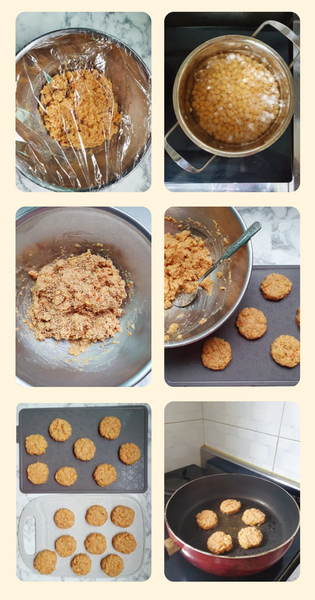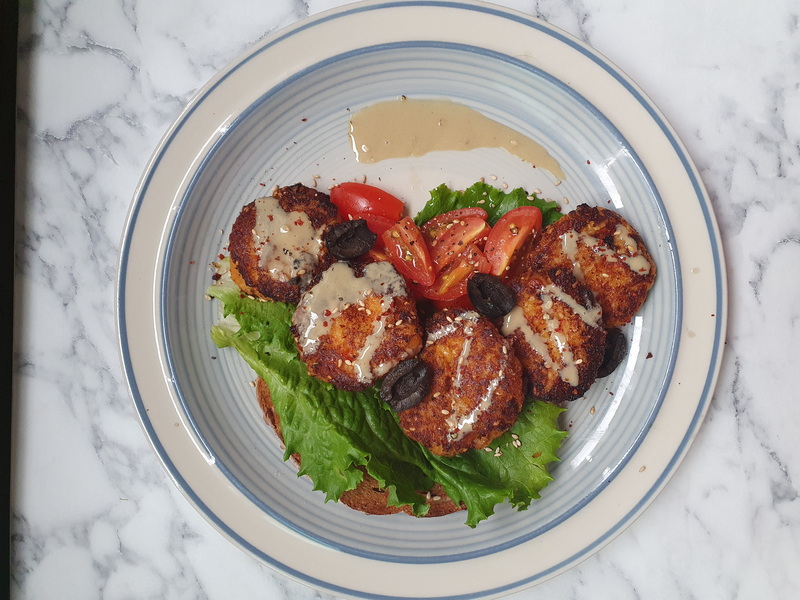Eating Plant-Based: Korean-Spiced Falafel Recipe
By Nicky Archer
Vegetarianism / Veganism in the UK
Over two decades ago, eating out at a restaurant in the UK as a vegetarian was often a dish minus the meat or a token mushroom taking center stage. Now, I have nothing against mushrooms, as they can be as versatile as any vegetable, but it is not always the main ingredient you desire as a child. I turned vegetarian when I was really young because of my ethical beliefs around animal wellbeing. Now though, in the UK, there is currently a huge shift happening, as more and more people begin to understand the immense benefits eating a plant-based diet can have on their health, animal suffering, and the environment.
Big cities such as London, Manchester, and Bristol have all seen an increase in cafes and restaurants serving vegan food only. Not only is this changing the way people eat but the way we think and engage with our food, too. Supermarkets are finally starting to listen more to what their compassionate, eco-conscious customers want, diversifying their aisles with alternative meat proteins such as tofu, seitan, legumes, nuts, and seeds as well as dairy-free alternatives to milk, yogurt, and cheese. Before, being a vegan meant giving up more foods than you could eat; now you can get almost anything minus the cruelty and with a reduced carbon footprint. Supermarkets still have a way to go to reduce their levels of plastic waste, but in the UK at least, plastic bags are becoming a thing of the past with a new tax being brought in back in October 2015.
Shopping, Eating, and Cooking in Gwangju
Coming from having a myriad of plant-based produce at my fingertips to navigating my way through Korean markets carrying foreign goods with limited Korean language knowledge, it has not been easy. I have spent hours scouring ingredient labels of packaged goods using translation apps to discover if it is suitable or not. However, it is not an impossible feat. Finding Korean recipes online such as doenjang jjigae (soybean paste stew) or bulgogi wraps (made with tofu or mushroom instead of meat) allows for a more targeted shopping experience. When it comes to eating out, there are the staples such as kimbap, bibimbap, and naengmyeon that can almost always be ordered in most places without the meat (or egg).
As a long-term strict vegetarian, falafels have always been a favorite. Usually easy to come by or make at home, they work great as a snack, lunch, or dinner. (Even as a cold breakfast food, I would not say no!) Generally, most falafel recipes I have come by always include coriander, parsley, and cumin. Although it is not impossible to buy fresh herbs and spices here in Gwangju, I do not normally see them in my local mart. What I do see though is a lot of gochu-garu and sesame seeds. Gochu-garu is a beautiful, vivid, red chili powder that can be found in gochu-jang paste and is commonly used in Korean cuisine. Gochu-garu adds spice to a dish while sesame seeds can add a nice nutty flavor. So, as I experimented with falafel-making one recent Saturday, I set out to include those ingredients in one of my falafel batches. And it worked!
Recipe Introduction
Falafels really are truly versatile, adaptable, and forgiving. You can create them to your taste by adding more or less of a spice or herb or by including spring onions or chili peppers, or you can even make them gluten-free by using chickpea flour instead of plain flour. Do not let the ingredients on any recipe become a barrier! Don’t have plum tomatoes? Use a different type of tomato, or even something other than a tomato! Can’t find any herbs? Use a spice instead! If you are keen to have a go at making a plant-based meal for whatever reason, just give it a try! It might be the inspiration you need to commence a healthier, cruelty-free, and more environmentally friendly diet.
The Recipe
Serves 4–5 people
Prep time: 1–1.5 hours
Cooking time: 20 minutes

Ingredients
200 g dried chickpeas (soaked overnight)
10 plum tomatoes
3 tbsp of plain flour
3 cloves of garlic
1 onion (white or red)
3–4 tsp toasted sesame seeds
2 tsp gochu powder (red pepper powder)
1 tbsp of olive oil (plus more for cooking with)
Squeeze of lime
Salt and black pepper to taste

Preparation
- Soak your dried chickpeas overnight or for at least 12 hours. Boil them for around 50–60 minutes until you can squash one between your fingers – that way you know they are ready! Put them aside to cool.
- Wash your tomatoes and remove the stems. Halve and blitz in a blender until mushy.
- Add salt, pepper, olive oil, the cooked chickpeas, salt, pepper, gochu powder, sesame seeds, chopped onion, and garlic into the blender and combine. Blend until it forms into a sticky dough-like consistency.
- Scrape the mixture into a bowl. Add the flour, some more sesame seeds, and mix thoroughly. This should form a dough that is not too sticky.
- Cover the bowl with cling film, and put it into the fridge for 1–2 hours to firm up the mixture.
- Shape the mixture into about 20 balls. They should be around the size of a ping pong ball. Next, flatten them slightly on the edges to form a small patty shape. (If you choose to make them larger, adjust the cooking time accordingly. Or if you want to keep them ball-shaped, turn them more frequently when cooking.)
- Cook the falafels in batches. For each batch, heat a large frying pan with 2–3 tbsp of olive oil and cook for 2–3 minutes. Leave enough room in the pan to turn them over halfway through.
- Drizzle falafel patties with tahini and serve warm with salad and bread. Alternatively, for a bit more of a Korean twist, try combining with fried mushrooms, Korean rice, vegan kimchi, or other pickled vegetables.
Photographs by Nicky Archer.
The Author
Nicky Archer is an ESL teacher and animal rights campaigner from the UK. She is a foodie, art enthusiast, and somewhat of an adrenaline junkie. Living in Gwangju, she enjoys coffee-shop hopping, mountain hiking, and learning new things.







